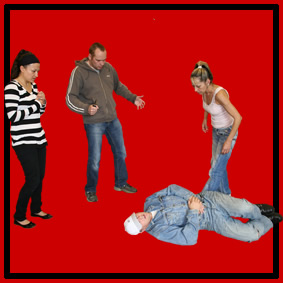drugs and
substance abuse
relationships and
domestic violence
knife crime
teenage pregnancy
and sexual health
consequences of
offending
skills for independent living
restorative
justice
bullying and emotional literacy
primary to
secondary
transition
alcohol misuse
exploring diversity and community cohesion |
FACING UP
Knife Crime
Facing Up was launched in July 2008 and represents the latest evolution of ADAD's response to violent 'street' crime, work that originated in 1996. In developing the programme ADAD had a keen awareness that young people are potentially both perpetrators and victims of such crimes. The development, initial piloting and current evolution of the programme was supported by The Thames Valley Partnership, The Gulbenkain Foundation, Islington Community Safety, The Metropolitan Police and The Cripplegate Foundation.
Target audience
Facing Up
is suitable for young people in Mainstream Education aged 13 upwards. The programme has also proven to be highly effective within Pupil Referral Units, as well as within most SEN schooling (subject to consultation). Facing Up can also been used in Conference and Training events.
Objectives
- To consider what constitutes an offensive weapon, why a young person may choose to carry one, and the potential consequences of this (both legally and through increasing their chances of being involved in a violent incident).
- To explore acceptable strategies for self-protection and to re-iterate key personal safety messages.
- To consider how a need for acceptance, respect and kudos can not only fuel and escalate moments of confilct and confrontation, but also make it harder for an individual to 'back down'.
- To consider the role of those peripheral to a confrontation or violent assault, (those who do not actually commit the assault, but encourage it) and to clarify the serious legal implications of such behaviour.
- To consider the role of some young women and their expectation of behaviour (most notably machismo) from their boyfriends.
- To address the apparent desensitising of some young people to the impact of street violence, and the belief that it is an acceptable retribution for relatively minor 'wrongs' or a legitimate form of defence.
- To starkly consider the impact of knife crime on the victim, their family and friends.
- To uncompromisingly consider the impact of knife crime on the perpetrator. The practical reality of arrest, entering the criminal justice system and life in custody. To explore the harsh reality of the life-long legacy and emotional impact of living with the responsibility of committing a violent assault.
The play
The play tells Fizz's story, as he tentatively begins a relationship with Kat. Fizz is a promising athlete and begins to gain the respect and tutorage of Kat's father, who manages the local sports centre. One evening, at a bus stop, an 'exchange of words' with youths from a neighbouring postcode spirals into an aggressive confrontation, culminating in Fizz stabbing one with the knife he's been carrying for 'protection'. He is soon arrested, and enters the criminal justice system. We then see the fall out from the incident as he 'faces up' to the consequences of that momentary lapse of control and judgement, seeing the effects his actions is having on his own family, on Kat, and most poignantly on the family of his victim, as he meets a relative within a Restorative Justice Conference.
The workshop
The workshop employs a variety of discussion and participatory techniques to explore the issues raised in the play.
Through the use of props, a definition is achieved of what constitutes an offensive weapon. What might the legal consequences be for carrying an offensive weapon, and in reality, are we safer if we carry one?
The audience are asked to consider the victims of the events in the play, are they simply those present at the scene, or can the net be cast wider than that? How might each of these victims feel and what might the long and short term effects be on them?
The central focus of the workshop is on the build up to the stabbing. the role of each of the characters present is carefully analysed and the audience is able to explore in depth, how they may each have contributed to the final outcome. Ultimately audience members are able to experiment (in role) with how they might be able to diffuse the situation and prevent the stabbing without putting themselves in any unnecessary danger.
A comprehensive resource pack is soon to be available with this programme.
|
    |





